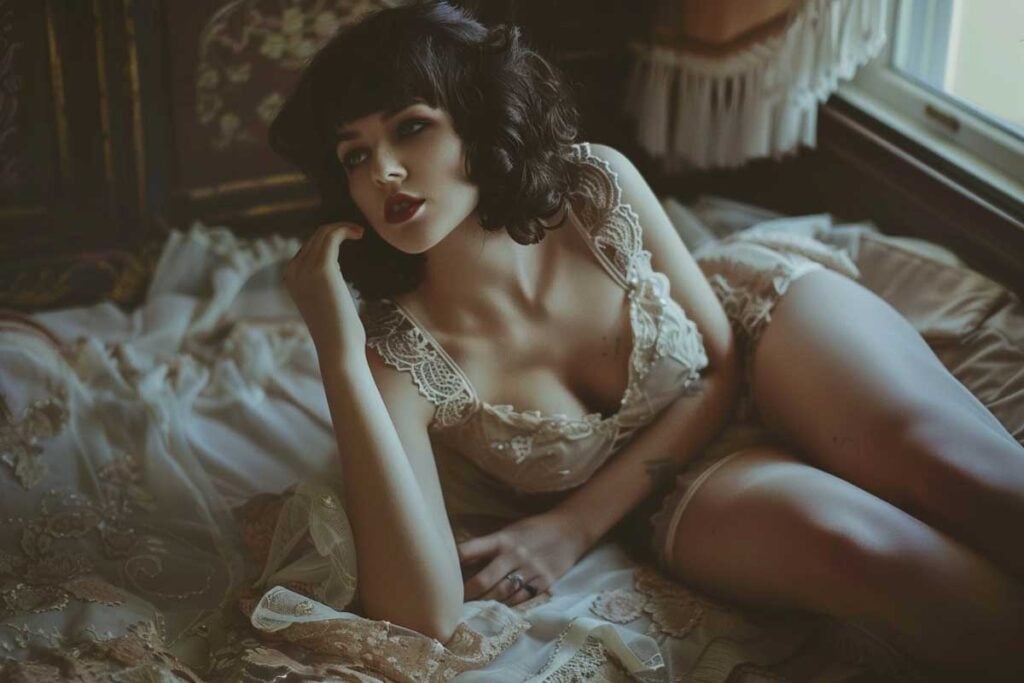
“Exposed: A History of Lingerie” at Museum at FIT sheds light on underwear
“Exposed: A History of Lingerie” June 3, 2024 – November 15, 2024 The Museum at FIT Fashion Institute of Technology Seventh Avenue at 27th Street, New York City, 212-217-4558
Hours: Tuesday – Friday, noon – 8 p.m.; Saturday 10 a.m. – 5 p.m.; Closed Sunday, Monday & legal holidays.
Admission: Free and open to the public.
Ever wonder what women wore before the bra? Curious about corsets? Know what a “gay deceiver” is?
Now at The Museum at FIT you can uncover the history of vintage lingerie in the exhibit “Exposed: A History of Lingerie.”
Get up close to dressing gowns, bustles, petticoats, teddies, and the Wonderbra. These items date from the 18th century to today. Colleen Hill, the accessories curator at The Museum at FIT, curated the exhibit. The exhibit sheds light on the evolution and liberation of the female silhouette.
The free exhibit (yes, free!) Proper undergarments are essential for those who dislike tight Spanx. The women of the past faced even greater discomfort. Here are some lingerie fun facts you’ll learn at the exhibit.
The 1700s A busk was inserted into a corset’s (or stays’) center front sheath in the 1700s to straighten the torso. Whalebone, wood, or horn combs were intricately carved with messages. They were given as gifts.
Women in the late 1800s wore peignoirs, light dressing gowns, at home without corsets. Peignoir comes from the French word “peigner,” meaning “to comb.”
Until the 1880s when color became fashionable, most corsets were white. As part of mourning costumes, widows often wore black corsets.
The crinoline of the 1860s was a stiffened petticoat supporting a woman’s dress. It led to the 1880s bustle, accentuating a woman’s rear end.
A crinolette is a mix between a bustle and a petticoat that was worn circa 1880.
Stockings in the late 19th and early 20th centuries had intricate designs and embroidery on feet and calves. Red stockings were very fashionable.
In the 1910s and 1920s, women wore bust supporters to create a monobosom. This gave the illusion of a single large bosom.
Women in the late 1910s and 1920s wore camiknickers. Camiknickers evolved from combination garments that combined a camisole and drawers. Camiknickers created the lean silhouette popular in 1920s clothing.
Bandeau bras from the 1920s flattened the bosom for curveless fashions.
Women in the 1930s wore corselets, which were all-in-one girdles. The corselets lifted breasts and smoothed hips. They also cinched waists and ended with attached slips.
In the 1930s, drawers (underwear) were made shorter and more fitted and were called briefs.
Nylon stockings debuted in the 1940s. They gained popularity for being durable and affordable compared to silk. During World War II, there was a shortage of nylon stockings. The material was used for military parachutes and fuel tank liners.
Flat-chested women in the 1950s wore “gay deceivers” in their bras. They aimed to achieve the full-busted look popularized by Christian Dior’s “New Look” in 1947.
Claire McCardell used nylon in her clothing designs in the 1950s. She was one of the first designers to do so.
Actress Carroll Baker popularized the baby doll nightgown trend in the 1956 film “Baby Doll.”
In the mid-1960s, designer Rudi Gernreich created the “no-bra bra.” It was wireless and had no padding.
Brightly colored hosiery was trendy under miniskirts in the mid- to late-1960s.
The Wonderbra, the most famous padded push-up bra, debuted in 1961. Sales soared in the early 1990s.
1970s Victoria’s Secret was founded in 1977 as a mail-order catalog and became known for its brightly colored underwear and bras.
Designer Jean Paul Gaultier popularized wearing underwear as outerwear in the 1980s. He is known for designing Madonna’s cone-shaped bras and corsets.
The Museum at FIT exhibition’s companion book “Exposed: A History of Lingerie” is available from Yale University Press.
More resources:
Exposed: A History of Lingerie

Peeking into “Exposed: A History of Lingerie” at The Museum at FIT is like opening a wardrobe to the past. I walked through delicate fabrics and evolving designs. Each piece tells a story of women through the centuries.
The display showcases vintage lingerie from the 18th century to today. Colleen Hill curates pieces that explore intimate apparel’s influence on fashion. Her work also examines women’s societal roles.
The Era of Social Changes
I learned how lingerie reflects women’s changing roles during my exhibit visit. The corset’s loosening laces reflected early women’s rights movements. The bra was invented during the assertive twenties. Women were gaining independence.
Advancements in Comfort
I learned about the invention of stretchy fabrics, which was a game-changer. Women swapped rigid corsets for elastic girdles. I imagine them sighing in relief. The touch of Lycra must have felt revolutionary, allowing lingerie to be as comfortable as it was supportive.
Fashion Icons’ Influence
I saw the influence of stars like Marilyn Monroe. Her love for the lift and shape of a good bra popularized its design. This impacted what was sold in stores and what women like my grandmother wore.
Economic Growth of Lingerie
The booming lingerie businesses tapped into every woman’s desire for chic comfort. Smart marketing made this possible. Companies like Victoria’s Secret sold an experience, a promise of glamour.
Lingerie in Pop Culture
The exhibit highlights moments where lingerie appeared on the big screen. One example is the “Baby Doll” nightgown. I could picture the scenes. The public was shocked. Women rushed to department stores to get a piece of that rebellious spirit.
Psychological Effects and Empowerment
You find research at the exhibit showing lingerie boosts confidence. It’s not just about looking good but feeling powerful in your skin—a sentiment as true now as it was back then.
Fashion Meets Function
The balance between beauty and utility is evident in every stitch and seam. Women have always wanted functional and fashionable lingerie.
Changing Perspectives on Body Image
The exhibit doesn’t shy away from tough conversations, either. It prompts thoughts on how advertising has evolved, from an era of one-size-fits-all to today’s celebration of all bodies, all shapes, all sizes.
Global Influence and Trends
Western trends influenced global fashion, introducing silhouettes and styles. These were adopted and adapted across oceans.
Sustainability in Lingerie
And the most modern twist? A nod to sustainability, a topic close to my heart. The trend towards eco-friendly fabrics and ethical production reflects the demand for responsibility in fashion.
The exhibit traces women’s history through clothing, not just frills and lace. It explores garments worn closest to the skin. It’s a must-see for the beauty of the garments. The stories they tell are about us, freedom, fashion, and finding our place in the world.
Keep up with the latest vintage clothing news on Twitter @BlufashionCom, Facebook, Pinterest, and Instagram.
Suggested Reading:
Iskra Banović is our seasoned Editor-in-Chief at Blufashion. She has been steering the website’s content and editorial direction since 2018. With a rich background in fashion design, Iskra’s expertise spans across fashion, interior design, beauty, lifestyle, travel, and culture.




